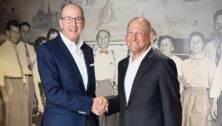Firstrust CEO and President Tim Abell Reflects on Bank’s FY2022 as Precursor to Overall Economic Outlook


Firstrust Bank CEO and President Tim Abell — before introducing speaker Lara Rhame, Chief U.S. Economist Lara Rhame at Philadelphia‘s FS Investment — reflected on the past year at a recent meeting of the Philadelphia Chamber of Commerce.
“A New Building Block”
“Some people like to think of the new year as a fresh start,” he began. “I like to think of it as a new building block. We don’t wipe the slate clean; we learn, and we grow, and then we move forward.”
Quick to acknowledge lingering business setbacks across various industries, Abell said, “Wisdom is sometimes born from hardship. And it has been inspiring to see how so many businesses have responded, to see the resiliency, to see the ingenuity.”
Following a brief mention of the bank’s association with the Philadelphia Eagles (garnering enthusiastic applause), Abell ceded the stage to Rhame.
Recession
Rhame, recognizing the elephant in the room, immediately addressed the threat of recession.
“The probability of a recession in the coming year has risen,” she began. But she clarified that prediction with the observation that even if the economy manages to sidestep recession, “It’s unlikely to be a year of really robust growth.”
That said, she advises preparedness, citing a need to venture into 2023 with “…our eyes wide open to some of these cyclical headwinds [and] macroeconomic challenges.”
She sketched a portrait of the U.S. economy as it exists presently.
“We look at real [Gross Domestic Product] GDP as the broadest measure of output and growth. The start of 2021 [saw] truly strong but unsustainable pace of growth,” she observed.
“And since then, growth has decelerated in a rocky deceleration. The first two quarters of last year, we actually had negative GDP growth.”
Some of that she attributed to “a lot of noise that’s related to the pandemic. Things like inventory swings and international trade … .”
She reframed the analysis around what she identified as clearer bellwethers on economic robustness: the “domestic demand” spending habits of U.S. households, businesses, and government.
And from that perspective, Rhame gains cautious optimism.
“We get a view of the economy that was positive but was still somewhat stagnant,” she noted.
Labor
Rhame then turned to what she identifies as the clearest predictor of extended sluggishness: the labor market.
“When we look at job growth and monthly job changes, we see a really strong view of 2022,” she observed.
She went on to explain that of all the indicators for recession, job loss is the clearest indicator that trouble is brewing. Robust job statistics a year ago (4.5 million positions and an unemployment rate of 3.5 percent) offset the predicted woe contained in the negative GDP numbers from the same timeframe.
Reconciling the stagnant financial environment and a widespread hiring spree becomes a difficult assessment. That disconnect was seen in the numbers: businesses added heads, but productivity growth didn’t follow. The dichotomy adds to the current uncertainty.
“[It’s] like a commute on the Schuylkill Expressway,” she said, raising a reference the audience could easily conjure.
“You round the corner, and you see all of these lights and you’re like, ‘Are we slowing down? Or are we stopped? Are we going to be here for a while? Or is this temporary?’”
Inflation
“No look at the economy would be complete without thinking about inflation,” Rhame continued.
“If 2022 gave us anything, it was a reminder that we all hate inflation. Because it eats everything: our savings, our wages, our investment returns.
“And it really exploded — the genie flew out of the bottle — in the middle of 2021. And it has been hard to put back in the bottle.
“We probably — hopefully — peaked at over nine percent in the middle of 2022. And inflation has come down.
“My year-end forecast for the next year is inflation of 3.5 percent; it’s still persistently above that two-percent comfort level,” Rhame predicted.
What’s Ahead
“When we think about the economy in the coming year, we are likely facing some challenges,” Rhame said. “But since we know it’s coming, we can adjust to it.”
She believes that should a recession ensue, it is likely to be mild.
She bases that assessment on performance indicators that include the housing market. Millennials, she hypothesized, may be the answer to its stabilization, as their burgeoning careers enable them to obtain residential real estate.
It’s a purchasing trend that may spell good news for the auto industry as well.
Final Thought
Rhame concluded by recognizing the limits to her forecasts. “I don’t have a perfect crystal ball,” she warned. “But I see a lot of reasons for positivity in the ability for all of us to navigate [recession].”
_____
Lara Rhame has become a trusted resource about the nation’s economy;
here she is in an Aug. 2022 Bloomberg discussion about recession.
Connect With Your Community
Subscribe for stories that matter!
"*" indicates required fields




























